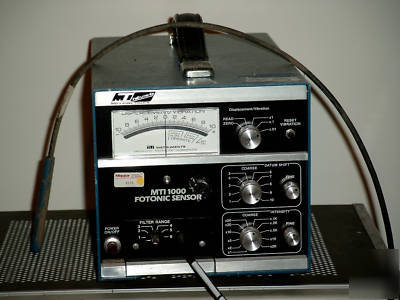Wisconsin Parts Database Instructions and Discussion Team/Group > OTHER STATES
> Industrial Parts
> Add
> New
> Without Warranty
> Mti 1000 fotonic sensor w/optical probe
Mti 1000 fotonic sensor w/optical probe
Taken from MTI Instruments website.
Surface Finish and the Fotonic Sensor
MTI Instruments has run a series of experimental tests using a standard MTI-1000 Fotonic Sensor looking at various
surface fi nish samples. These tests were conducted by adjusting the MTI-1000 for normal operation against a 2-L
surface; and then without changing this adjustment, other surface samples were substituted. 2L is a fi nely lapped,
mirror-like surface. The additional samples were 8L, 16G, 63G, 63P, and 125M. These are considered standard
surface fi nish reference numbers used throughout the machine tool industry and represent a wide variation in fi nishes.
When using the Fotonic Sensor to measure smoothness or surface fi nish, the probe is usually separated from the target
(specimen) at a distance which puts the standard Fotonic Sensor curve at its output peak. The output is comparatively
insensitive to displacement resulting from non-fl at surfaces or slight deviation from true perpendicularity of the
probe. The Fotonic Sensor then becomes sensitive only to smoothness or color changes.
Surfaces under observation should be clean and free from oil, rust and dirt. The calibration standards should be of
the same general color as the item to be observed. Since no carrier frequencies are used in the electronics and the
frequency response of the pickup goes as high as 2 MHz; it is possible to scan larger surfaces faster. In-line examination
of the entire surface of all parts is also practical. The Fotonic Sensor can detect surface scratches smaller than a
microinch wide or deep. Without motion, the instrument may integrate smoothness over the entire area being viewed
Advantages Over Stylus Measurements
Fotonic Sensors have several fi ber optic arrangements and each have somewhat different capabilities. It is possible to
measure smoothness without even moving the probe or part; whereas motion is necessary with stylus measuring means.
Since most surfaces have a different roughness in different planes or directions, it is often diffi cult to say just what
overall fi nish actually is. A groove may have a very smooth bottom in which the stylus rides - and a very rough side and
peak. The roughness of a surface may vary over several orders of magnitude when measured with a stylus, depending
upon the direction of measurement.
MTII appnote: fotonicsmoothness.pdf - page 1 of 2
****@mtiinstruments.com
Friction and wear are more a function of average smoothness. Therefore, since the Fotonic Sensor tends to integrate the
surface being observed, the results often tell a more conclusive story than fi ndings obtained by running a stylus down
a groove. More consistent indication of fl uid seal leakage is possible using the Fotonic Sensor than with the traditional
stylus types of surface fi nish measurement. Except for the obvious scratch through which fl uid may leak, the leakage
seems to be related to peak or ridge roughness which elevates the seal from the surface dynamically or statically.
It is also possible to measure surface smoothness during machining on a cut previous to the last or even during the fi nal
machining operation. One can then change conditions before scrapping a part which is one dimension but which may
have an inferior surface fi nish. Adaptive and on line measurements of fi nish are therefore practical and can be made
a part of existing and future machines.
The graph below shows these results. We then mathematically normalized each output curve and plotted them individually
as compared to the reference 2L surface.
These results are signifi cant in that they show a relatively small error in our standard calibration procedure regardless of
the extreme variation in surface fi nish and condition. This accuracy exists up to a No. 63 surface fi nish with only about a
.5 mil equivalent displacement error up to a No. 500 surface. The dynamic error, i.e. slope of calibration curve, is nearly
undetectable and is probably less than the experimental error of the tests themselves.

